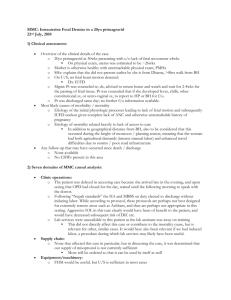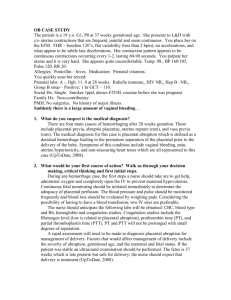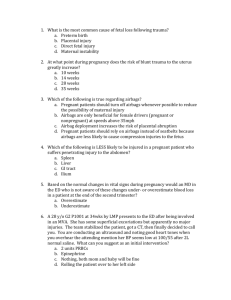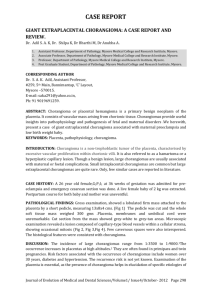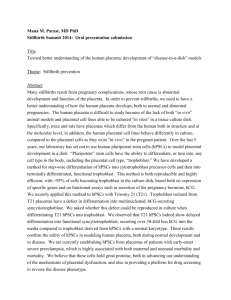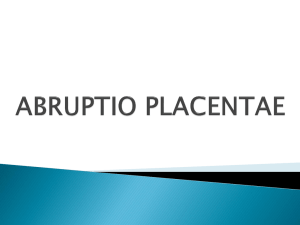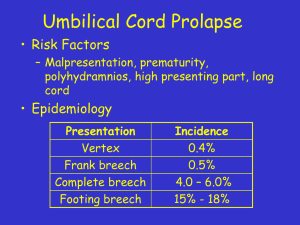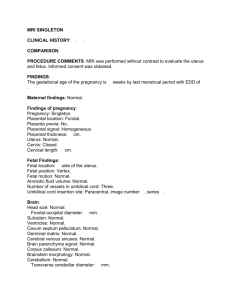03._IUFD
advertisement
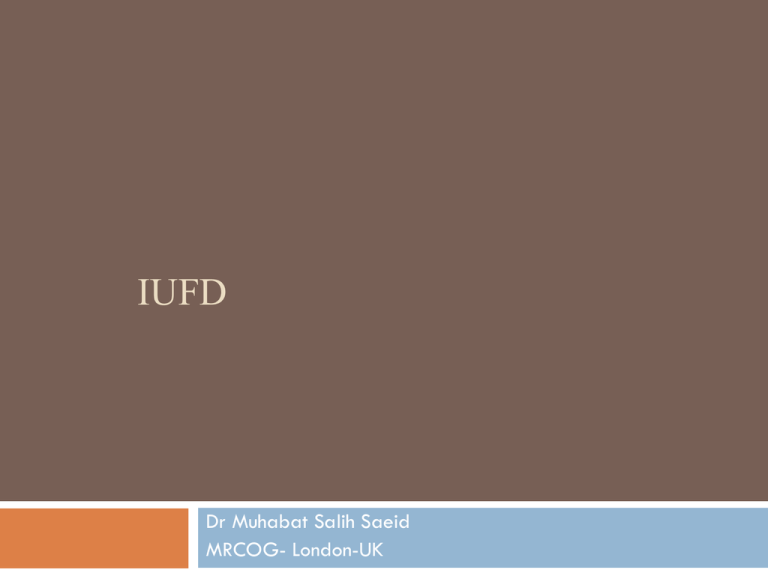
IUFD Dr Muhabat Salih Saeid MRCOG- London-UK Definition: dead fetuses or newborns weighing > 500gm Or > 20 wks gestation Diagnosis Absence of uterine growth Serial ß-hcg Loss of fetal movement Absence of fetal heart Disappearance of the signs & symptoms of pregnancy X-ray Spalding sign Robert’s sign U/S 100% accurate Dx Spalding sign Causes of IUFD Fetal causes 25-40% • Chromosomal anomalies • Birth defects • Non immune hydrops • Infections Causes of IUFD Placental 25-35% • Abruption • Cord accidents • Placental insufficiency • Intrapartum asphyxia • Placenta Previa • Twin to twin transfusions • Chrioamnionitis Placental abruption Maternal 5-10% • • • • • • • • • • • • • • Antiphospholipid antibody DM HPT Trauma Abnormal labor Sepsis Acidosis/ Hypoxia Uterine rupture Post term pregnancy Drugs Thrombophilia Cyanotic heart disease Epilepsy Severe anemia Unexplained 25-35% A systematic approach to fetal death is valuable in determining the etiology A-Family history • Recurrent abortions • VTE/ PE • Congenital anomalies • Abnormal karyotype • Hereditary conditions • Developmental delay B-Maternal History I-Maternal medical conditions • VTE/ PE • DM • HPT • Thrombophilia • SLE • Autoimmune disease • Severe Anemia • Epilepsy • Consanguinity • Heart disease II-Past OB Hx • Baby with congenital anomaly / hereditary condition • IUGR • Gestational HPT with adverse sequel • Placental abruption • IUFD • Recurrent abortions Downs syndrome Current Pregnancy Hx • Maternal age • Gestational age at fetal death • HPT • DM/ Gestational D • Smoking , alcohol, or drug abuse • Abdominal trauma • Cholestasis • Placental abruption • PROM or prelabour SROM Specific fetal conditions • Nonimmune hydrops • IUGR • Infections • Congenital anomalies • Chromosomal abnormalities • Complications of multiple gestation Hydrops Fetalis Placental or cord complications • Large or small placenta • Hematoma • Edema • Large infarcts • Abnormalities in structure , length or insertion of the umbilical cord • Cord prolapse • Cord knots • Placental tumors 2-Evaluation of still born infants • • • • Infant description Malformation Skin staining Degree of maceration Color-pale ,plethoric Maceration Umbilical cord • Prolapse • Entanglement-neck, arms, legs • Hematoma or stricture • Number of vessels • Length Amniotic fluid • Color-meconium, blood • Volume Membranes • Stained • Thickening Placenta • Weight • Staining • Adherent clots • Structural abnormality • Velamentous insertion • Edema/ hydropic changes Investigations Maternal investigations • CBC • Bl Gp & antibody screen • HB A1 C • Kleihauer Batke test • Serological screening for Rubella • CMV, Toxo, Syphilis, Herpes & Parovirus Karyotyping of both parents (Baby with malformation) • Hb electrophoresis • Antiplatelet antibodies • Thrombophilia screening (antithrombin, Protein C & S , factor V leiden, lupus anticoagulant, anticardiolipin antibodies) Fetal investigations • • • • Fetal autopsy Karyotype (specimen taken from cord blood, intracardiac blood, body fluid, skin, spleen, Placental wedge, or amniotic Fluid) Fetography Radiography Placental investigations • • • • • • Chorionocity of placenta in twins Cord thrombosis or knots Infarcts, thrombosis, abruption, Vascular malformations Signs of infection Bacterial culture for Ecoli, Listeria, gp B strpt. Management Expectant approach: 80% goes into spontaneous labour within 2-3 weeks Active approach: b/o emotional burden, risk of chorioamnionitis, and 10% risk of DIC (if >5wks). Induction of labour can be initiated at any time. IUFD complications • • • Hypofibrinogenemia 4-5 wks after IUFD Coagulation studies must be started 2 wks after IUFD Delivery by 4 wks or if fibrinogen <200mg/ml Psychological aspect & counseling • • • • • A traumatic event Post-partum depression Anxiety Psychotherapy Recurrence 0-8% depending on the cause of IUFD Thanks for listening!
